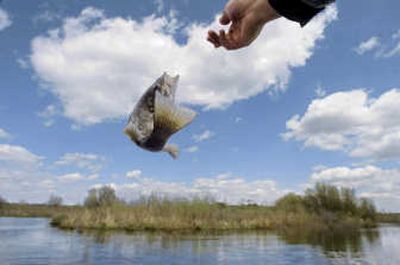Lure of the desert

Levi Meseberg is a man prepared to fish Potholes Reservoir. His 21-foot Ranger fishing boat is festooned with a forest of fishing rods. He has rods for flipping plastic baits, pulling crank baits, casting tube baits, pulling worm harnesses. He has rods with bait-casting reels and others with spin-casting reels.
While the former guide’s arsenal might be more than most anglers have or need, it reflects the options in this massive lake – home to 22 species – south of Moses Lake in Grant County.
The fishing for the big three – walleye, largemouth and smallmouth bass – is so good that Potholes is the site of fishing tournaments every other weekend from spring through fall. Anglers also catch rainbow trout, yellow perch, crappie, bluegill and bullhead catfish.
Meseberg (pronounced MEES-berg) grew up fishing the lake while working at the family’s MarDon Resort on the lake’s south shore. He guided for more than four years, but now serves as the resort’s head of maintenance, which allows him more time for tournament fishing, and fishing for fun.
Walleyes: In a fisherman’s tour of the lake in May, Meseberg first headed east from the resort a third of the way up Lind Coulee. He put bait on the worm harnesses and fished using the bow-mounted trolling motor.
Trolling with worm harnesses – a combination of hooks, colored plastic beads and a small metal blade – is the most effective means of chasing Potholes walleyes. It’s a big reason the resort sells 600 to 800 dozen a week during the summer.
He fished a ledge about 20 feet below the surface. The walleye were suspended in deeper water just below the ledge.
Each time he made a pass, Meseberg kept an eye on his Lowrance LCX-28C fish finder. “There’s some fish,” he said pointing to the color screen.
Almost without fail, within moments one of the anglers in the boat would hook a fish.
Now that the waters have warmed, Meseberg would recommend trolling at 1.5 mph.
Bass: After a short run, Meseberg positioned the boat near rock piles off the face of O’Sullivan Dam and switched to crankbaits for smallmouth bass.
Fishing along the dam, Meseberg pointed out the occasional rock that poked up through the lake’s wind-rippled surface. “That’s the thing about this lake. A spot you caught a fish at in the spring, you come back in August and it will be dry land,” he said.
Water from the reservoir is used for farm irrigation. As the summer heat builds, the lake is drawn down. “The lake is always changing, and the fish are moving from one spot to another. Anglers must be willing to move, too, he said.
For largemouth bass, Meseberg motored to Frenchman Hills Wasteway along the north edge of Potholes State Park. He worked the boat up what is essentially a creek, fed by unused and returned water from the irrigation system west of the reservoir.
Casting plastic baits among the tangle of willow roots that lined the bank failed to produce any fish. So he switched to casting leeches – live and artificial – into the channel and slowly retrieving them.
He landed the first largemouth bass of the day and more smallmouth, including one that weighed 3 pounds.
As afternoon gave way to evening, the temperature cooled and the fishing slowed. It was time to head back to the resort. Graceful white egrets stalked the shallows, while red-winged blackbirds chattered from tall reeds along the shore.
A great horned owl sat in a nest, protecting a fuzzy owlet peeping over the edge. Western grebes, often in pairs, dove under the water as the boat buzzed by.